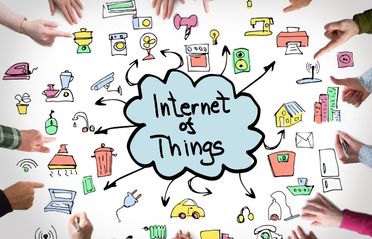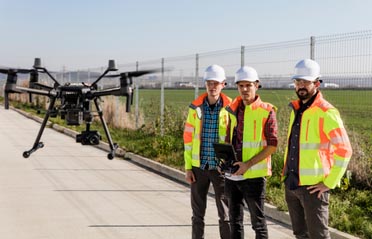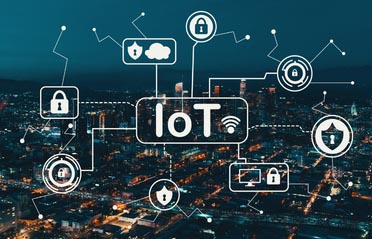The covid-19 pandemic has been a proven catalyst in the adoption and innovation of new technologies, ramping up the speed through which none of the industry experts could have anticipated. Organizations, while adapting to the new normal, have accelerated their digital transformation journey at least by three to four years. It has been reported that at least 77% of the CEOs stated that the COVID-19 pandemic has accelerated their digital transformation plans. This has resulted in businesses implementing cutting-edge technologies to transform their business processes to stay competitive and generate new revenue streams.
In one of our earlier posts, we had evaluated how COVID has accelerated the adoption of certain technologies and trends. In this post, we will include a few other industries that have accelerated their digital journey owing to the pandemic.
Telecommunications
The pandemic accelerated structural challenges faced by the Telecommunication industry. Having said that, the adoption of certain technologies has also paved a path for new growth opportunities for the sector, as it proved to be the savior for companies as well as individuals during the incessant lockdown. With organizations moving online almost overnight, they had to rely heavily on connectivity to make remote working possible.
It has been estimated that network traffic has seen an almost 50% increase since the beginning of the outbreak. This is driven by exponential demand for higher bandwidth to make use of various services like content streaming. This has also resulted in the expansion of the daily traffic peak from two hours to anywhere from six to 10 hours, which often tests the resilience of our existing telecom networks. Vodafone UK, for example, experienced a 30 percent increase in mobile Internet traffic and a 42 percent increase in mobile voice traffic due to the crisis.
With surging network traffic and data need, new technologies have made great inroads in the Telecommunications space.
Advanced wireless networks:
5G and Wi-Fi 6 provide higher bandwidth, reduced latency, and high data intensity which foster smooth and speedy internet. Thus, altering the way organizations operate to provide more efficiency especially in time-sensitive applications like gaming, self-driving cars, and the Internet of Things (IoT) which is basically used in every industry today.
Organizations like Telekom Malaysia deployed 5G base stations at few quarantine centers that deliver free Wi-Fi to patients and medical staff. It also provided 50 5G fixed wireless access terminals to cater to the rising data demands. As COVID-19 continues its rampage, the telecom industry will boost advanced digital infrastructure with the advent of 5G and Wi-Fi 6.
Real Estate
An industry often considered to be a slow adopter of modern tools and technologies, COVID acted as a disruptor where lockdown of physical spaces and stringent protocols for maintaining physical distancing magnified the need for digitization. Since customers were physically not able to visit, it opened new opportunities for the Proptech industry to adapt and evolve and introduce new technologies that made way for virtual experiences, thus, simplifying the procedure for customers even in the future.
Augmented and virtual reality:
The real estate industry has evolved from print catalogs as marketing assets to interactive demonstrations on a mobile screen. Now real-estate businesses have adopted new-age marketing strategies such as Augmented Reality mobile apps that create 3D models and offer virtual tours to present a natural experience to the customers. While the concept has been adopted at a large scale in most of the developed countries, it is still at a nascent stage in developing countries like India. Tech-enabled real estate platforms like Nobroker.com had launched a video walkthrough last year when customers could not visit properties due to a nationwide lockdown.
Robotic Process Automation (RPA):
Robotic Process Automation technology provides a virtual workforce that works faster than a human worker and flawlessly without making any mistakes. It does not require any monitoring or incentives, yet it can work tirelessly. With features like natural language processing, text analysis, and optical character recognition it assists in eliminating repetitive low-value tasks and manual labor hence improving the workflow.
RPA was already a prominent technology being utilized in the real estate environment to boost daily business and transactions and gained tremendously by reducing manual effort with data-intensive activities. COVID pushed the relevance of the technology further towards leveraging Artificial Intelligence and Machine Learning where robots find patterns, build rules of their own, and take decisions along with process automation.
Internet of things (IoT):
Cutting-edge technology like the Internet of Things (IoT) has transformed the real estate industry into Smart Real Estate that functions on the basis of real-time data, providing an insight into the functional performance of a building and enhancing its tenants’ experience. IoT has turned any physical object related to the building performance into a source of information.
Covid brought the concept of Social Distancing which affected the practice of how people interacted with physical spaces. The outbreak demanded a change in the traditionally accepted business practices in the sector. IoT-enabled devices assisted in complying with Covid-posed restrictions by tracking and reporting if requirements for social distancing and wearing masks are being met within real estate offices. IoT sensors are also being used now to monitor and report the air quality inside the premises of many real estate companies.
As more real estate companies invest in modern technologies in order to survive the pandemic and create new revenue opportunities, IOT indeed has led customers to appreciate the new trend which has resulted in increased revenues for the industry.
Oil and Gas Industry
Global energy demand stalled as countries started imposing lockdown last year. Although a majority of the Oil and Gas companies were forced to abandon the plans and projections they had prepared before the pandemic struck, it also paved the way for a faster digitalization of the Oil & Gas industry.
COVID-19 environment and resulting remote working policies created the platform to expedite some of the change necessary to support the full integration of digital technology across the oil and gas industry.
Cloud-based systems & IoT connectivity:
Having opened up a sensor-loaded world with endless possibilities, cloud-based systems coupled with IoT devices have built the industry’s trust in digital technologies a notch higher. The new wave of remote workers relies heavily on digital platforms to conduct business as close to normal as possible and such technologies enable this by harvesting unprecedented amounts of data volumes to streamline and automate operations.
Cloud-based systems ensure access to databases to all employees which connect to other devices with IoT and can help send alerts in case of oil spills, gas leaks, and other hazardous events. It accelerates performance through inventory management and tracking orders via IOT based sensors and updating it on a shared cloud platform.
Moreover, the concept of Digital twin also picked up the pace and is considered as one technology that can be key in such a challenging time. Creating a virtual replica of oil and gas infrastructure, or individual components, allows real-time tests and analysis to be conducted using operational data; this, in turn, optimizes the efficiency of processes and reduces costs without disrupting real-world processes.
Mobile platforms/apps:
Increasing ease and efficiency
Mobile devices help gather real-time information along with capturing accurate location and data for people in the field. The oil and gas industry works with multiple professionals like field executives, geologists, environmental specialists, managers and thus using traditional methods like pen and paper decreases the efficiency of the work.
Dedicated mobile apps can help in tracking and analyzing the to drive insights thus aid in predicting effective drilling spots.
Industrial Internet of Things (IIoT):
The backbone of the transformative IIoT trend is the linkage of connectivity, cloud, machine learning and advanced analytics technologies to simplify process automation. It can be implemented in Intelligent Pumps for the Digital Oilfield, Drone technology to inspect pipelines, Compressor Monitoring and Controls, Inventory Tank Gauging, and Leak Detection Systems to change the traditional practices altogether.
To be successful despite these current market conditions, oil and gas companies recognize the necessity of digital technology which offers viable solutions to reduce operating costs and magnify accuracy for the foreseeable future.
Banking and Financial Services
Banks and other financial services were already on the path of digital transformation much before the pandemic had struck and usually have a digital strategy of some kind. But Covid accelerated the customer expectations that demanded different strategies to be developed around innovation and digital banking. As the popular saying goes, ‘Some Day’ or ‘One Day’ has become ‘Today’.
Digital and contactless payments:
India’s digital payment giant Paytm registered 750 million transactions a month which surpassed pre-Covid levels. It reported having processed about 60% of the total transactions registered on its payment gateway through its digital instruments like Paytm wallet and Paytm UPI. Moreover, studies have shown that total spend worldwide through digital wallets will exceed $10 trillion in 2025. It found the growth in spending will largely be fuelled by the heightened adoption of digital payments during the pandemic.
Blockchain:
Financial services have centralized databases to ease the accessibility of data from various branches. These centralized databases are prone to data breaches and hacking, thus blockchain can benefit by making it secure and eliminate risks and fraud. Blockchain technology is immutable in nature which restricts any replication, thus ensuring the safety and veracity of data. In addition, it facilitates encryption using public and private keys which fosters privacy of data.
Another aspect of blockchain adoption is seen in the cryptocurrency space where more and more people are moving towards “Decentralised Finance (DeFi)” interest-earning platforms which have doubled their revenue from last year to over $855 million, offering greater interest rates on cryptocurrency deposits as compared to traditional bank deposits.
Artificial Intelligence:
Trust is a major factor in the banking industry. AI creates a secure environment for customers that instills trust through technologies like biometric identification, chatbots, loan application assessment, fraud detection, constant portfolio evaluation, and credit scoring. The AI algorithms assist institutions in predicting the churn rate and customer lifetime value.
The organizations have added more value through technology to the work-stream amidst the coronavirus pandemic. With the potential to reduce operational costs while improving efficiencies, these technologies will be potential game-changers in the near future.
Conclusion
COVID-19 has indeed demonstrated digital disruption in the way industries are creating value. The global crisis bought unprecedented risks which led to innovation and reimagining the future of business operations. HSC with its portfolio of solutions and accelerators can be a technology partner for these industries in their digital transformational strategy for the future.

 Product Engineering Services Customized software development services for diverse domains
Product Engineering Services Customized software development services for diverse domains
 Quality Assurance End-to-end quality assurance and testing services
Quality Assurance End-to-end quality assurance and testing services
 Managed Services Achieve scalability, operational efficiency and business continuity
Managed Services Achieve scalability, operational efficiency and business continuity
 Technology Consulting & Architecture Leverage the extensive knowledge of our Domain Experts
Technology Consulting & Architecture Leverage the extensive knowledge of our Domain Experts

























